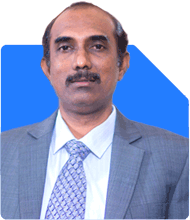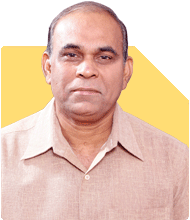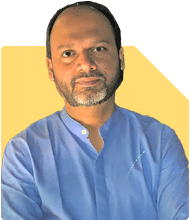I'm 41, earn 65k: Is my 50L house dream too risky?
Ramalingam Kalirajan |10876 Answers |Ask -Follow
Mutual Funds, Financial Planning Expert - Answered on Jun 03, 2025
He has an MBA in finance from the University of Madras and is a certified financial planner.
He is the director and chief financial planner at Holistic Investment, a Chennai-based firm that offers financial planning and wealth management advice.... more

Hello sir I am 41 years old and having 65k monthly salary I have 15k SIP n have 21L in mutual fund n 4L in Stocks also having PL 3.00 with EMI 11K Now want to purchase 50L house with loan plz guide me
Let’s look at your entire situation from a 360-degree view. We will analyse your income, debt, investments, insurance, and house purchase plan. Let’s start step by step.
Income and Current Obligations
Monthly income is Rs. 65,000.
EMI of Rs. 11,000 takes 17% of your income.
SIP of Rs. 15,000 takes 23% of your income.
You are left with around Rs. 39,000 for expenses and savings.
Budgeting is key at this stage.
You must manage cash carefully before adding any more EMI.
Existing Loan Needs Attention First
Personal loan of Rs. 3 lakhs is still running.
Personal loans have high interest rates.
Repaying this loan quickly should be a priority.
Try to close it in the next 12–18 months.
Avoid adding a new loan until this is under control.
Emergency Fund is Missing – It is a Must
No emergency fund creates financial stress.
Target saving Rs. 2–3 lakhs for emergency use.
Keep it in a liquid fund or savings account.
Don’t touch mutual fund corpus for this.
Emergency fund gives mental comfort during income disruption.
Mutual Funds – You’ve Done Well So Far
Rs. 21 lakhs in mutual funds is a good base.
Rs. 15,000 SIP shows regular investing habit.
This discipline will help long-term wealth creation.
Continue SIPs unless your cash flow is strained.
Review your mutual fund mix every year.
Avoid Direct Mutual Fund Investments
Direct mutual funds seem cheaper, but lack expert support.
Wrong fund selection can hurt returns.
Monitoring becomes difficult without guidance.
Regular plans through Certified Financial Planner give support and clarity.
Review, rebalancing and emotional discipline are offered in regular route.
Stocks – Keep Them in Moderation
You have Rs. 4 lakhs in direct stocks.
Stocks are volatile and risky without research.
Keep direct stock allocation under 10–15% of your total portfolio.
Focus more on mutual funds for steady long-term growth.
Buying a Rs. 50 Lakh House – Let’s Evaluate
You are interested in buying a Rs. 50 lakh house.
At your income level, this is a big commitment.
With a loan of Rs. 40 lakhs, EMI will be around Rs. 35,000.
Total EMIs will become Rs. 46,000 including personal loan.
This will take 70% of your monthly salary.
That is very risky and not advisable.
Home Loan Eligibility and Risks
Banks may not approve Rs. 40 lakh loan due to income level.
Even if approved, your savings capacity will vanish.
You may need to pause SIPs to manage cash.
That will affect your long-term wealth building.
What Should You Do Instead?
First build an emergency fund of Rs. 2–3 lakhs.
Try to close personal loan in next 12–18 months.
Increase savings by avoiding new EMIs.
Postpone home purchase by 2 years.
Save for down payment of Rs. 10–15 lakhs during this time.
Then go for a smaller loan like Rs. 30–35 lakhs.
Insurance – Protect Before You Grow
No insurance detail was mentioned in your question.
You must have term insurance for Rs. 50 lakhs or more.
Life insurance is needed to protect family.
Take a pure term cover, not endowment or ULIP.
Also take health insurance for yourself and family.
Avoid investment-cum-insurance products.
Investments – Review Your Approach
You are doing Rs. 15,000 monthly SIP.
Continue SIPs if income permits.
Use a mix of large-cap and flexi-cap equity funds.
Avoid index funds. They lack fund manager involvement.
Index funds copy the market. They don’t beat it.
Actively managed funds have potential to give better returns.
Good fund selection by a Certified Financial Planner adds value.
Future Goals – Don’t Forget Retirement
Retirement planning should begin early.
After house purchase, don’t forget long-term goals.
Keep investing regularly for your retirement.
Use long-term equity mutual funds for wealth creation.
Avoid pausing SIPs during short-term money stress.
Budgeting – Keep it Tight and Smart
With Rs. 65,000 income, strict budgeting is needed.
Don’t allow lifestyle inflation to rise.
Save before you spend, not the other way.
Don’t buy a big house just for social image.
If You Hold Endowment or ULIP – Act Wisely
If you have LIC or investment-cum-insurance policies, evaluate them.
Check if returns are low and lock-in is high.
You can surrender such policies if they don’t suit your goals.
Reinvest proceeds into mutual funds after consulting a Certified Financial Planner.
House Purchase – What Should be the Ideal Time?
House can wait till you are financially stronger.
Don’t mix emotions with big financial decisions.
Owning a house is good, but not at the cost of peace.
Wait for 2 years. Build savings and reduce existing loan.
Then purchase a house that fits your income.
Emotional Discipline – It Helps More Than You Think
Emotional buying leads to wrong loan decisions.
Control urges to buy just because others are buying.
Peace of mind is better than financial pressure.
Business Opportunity – Explore Side Income
You can try a part-time business or freelance work.
Use extra income to repay loans and build corpus.
Explore skill-based earning models to boost cash flow.
Avoid Common Mistakes
Don’t use credit cards for expenses you can’t repay.
Don’t take gold loan or top-up loan for down payment.
Don’t buy house for rental income. Rent is not high in most areas.
Don’t pause insurance or SIPs for luxury purchases.
Finally
You have started well with Rs. 21 lakhs mutual fund and SIPs.
Your income is limited now, but your savings mindset is good.
Buying a Rs. 50 lakh house now is not financially safe.
Prioritise building emergency fund and closing personal loan.
Postpone house buying by 2 years and prepare well.
Take insurance seriously. Protect first, then invest.
Use mutual funds with guidance. Avoid direct or index funds.
Take support from a Certified Financial Planner to review overall plan.
Focus on small monthly improvements. They bring big results.
Best Regards,
K. Ramalingam, MBA, CFP,
Chief Financial Planner,
www.holisticinvestment.in
https://www.youtube.com/@HolisticInvestment
You may like to see similar questions and answers below
Ramalingam Kalirajan |10876 Answers |Ask -Follow
Mutual Funds, Financial Planning Expert - Answered on Apr 24, 2024
Ramalingam Kalirajan |10876 Answers |Ask -Follow
Mutual Funds, Financial Planning Expert - Answered on Jun 22, 2024
Ramalingam Kalirajan |10876 Answers |Ask -Follow
Mutual Funds, Financial Planning Expert - Answered on Jul 22, 2024
Ramalingam Kalirajan |10876 Answers |Ask -Follow
Mutual Funds, Financial Planning Expert - Answered on Jun 02, 2025
Radheshyam Zanwar |6740 Answers |Ask -Follow
MHT-CET, IIT-JEE, NEET-UG Expert - Answered on Dec 09, 2025
Naveenn Kummar |234 Answers |Ask -Follow
Financial Planner, MF, Insurance Expert - Answered on Dec 09, 2025
Ramalingam Kalirajan |10876 Answers |Ask -Follow
Mutual Funds, Financial Planning Expert - Answered on Dec 09, 2025
Ramalingam Kalirajan |10876 Answers |Ask -Follow
Mutual Funds, Financial Planning Expert - Answered on Dec 09, 2025
Radheshyam Zanwar |6740 Answers |Ask -Follow
MHT-CET, IIT-JEE, NEET-UG Expert - Answered on Dec 09, 2025
Radheshyam Zanwar |6740 Answers |Ask -Follow
MHT-CET, IIT-JEE, NEET-UG Expert - Answered on Dec 09, 2025
Nayagam P P |10853 Answers |Ask -Follow
Career Counsellor - Answered on Dec 09, 2025
Mayank Chandel |2569 Answers |Ask -Follow
IIT-JEE, NEET-UG, SAT, CLAT, CA, CS Exam Expert - Answered on Dec 08, 2025
Mayank Chandel |2569 Answers |Ask -Follow
IIT-JEE, NEET-UG, SAT, CLAT, CA, CS Exam Expert - Answered on Dec 08, 2025

Mayank Chandel |2569 Answers |Ask -Follow
IIT-JEE, NEET-UG, SAT, CLAT, CA, CS Exam Expert - Answered on Dec 08, 2025











.jpg)










